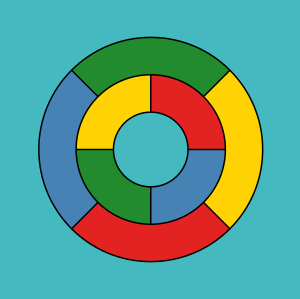Five color theorem facts for kids
The Five Color Theorem is a cool idea from Graph theory. It says that you can color any map using only five different colors. Imagine a map of countries or regions. The main rule is that any two countries that share a border must have different colors. Countries that only touch at a single point can have the same color.
This theorem was first suggested by Alfred Kempe in 1890. He also tried to prove it, but his proof had a small mistake. Eleven years later, in 1901, Percy John Heawood fixed Kempe's proof and showed that the theorem was true.
There is also a Four Color Theorem, which is even stronger. It says you only need four colors for any map! But proving the Four Color Theorem is much harder than proving the Five Color Theorem.
Contents
Understanding the Five Color Theorem
The Five Color Theorem is about how we can color maps without any two neighboring areas having the same color. It's a fun puzzle that mathematicians have studied for a long time.
What is a "Map" in Math?
When mathematicians talk about a "map" for this theorem, they mean any flat surface divided into different areas. Think of a puzzle where each piece is a "country" or "region." Each of these regions must be a single, connected piece. This means a country can't have separate parts, like an island far away from its main land.
The Rules for Coloring Maps
The rules for coloring these mathematical maps are quite simple:
- Rule 1: If two regions share a border (a line segment), they must be colored with different colors. You can't have two countries next to each other with the exact same color.
- Rule 2: If two regions only touch at a single point (like the corner of a puzzle piece), they can be colored with the same color. They don't share a border, so it's okay.
The Five Color Theorem tells us that no matter how complicated a map is, you will never need more than five colors to follow these rules.
The History of the Theorem
The idea of coloring maps has been around for a long time. It led to some interesting challenges for mathematicians.
Alfred Kempe's Contribution
The first person to state the Five Color Theorem was a mathematician named Alfred Kempe. He announced it in 1890. Kempe also tried to prove that it was true. His proof was very clever and almost perfect. However, it had a small flaw that someone else later found. Even with the flaw, Kempe's work was a very important step forward.
Percy John Heawood's Proof
The person who finally proved the Five Color Theorem correctly was Percy John Heawood. He was another mathematician who studied map coloring. In 1901, Heawood found the mistake in Kempe's proof. He then fixed it and provided a complete and correct proof for the Five Color Theorem. This showed for sure that five colors are always enough.
Five Colors vs. Four Colors
You might have heard about the famous Four Color Theorem. This theorem says that you only need four colors to color any map! This is even more amazing than needing five colors.
Why Four Colors is Harder
The Four Color Theorem is much more difficult to prove than the Five Color Theorem. It took many years and a lot of effort from different mathematicians to finally prove it. The first full proof of the Four Color Theorem was done in 1976 using computers. This made it a very special moment in math history.
Even though the Four Color Theorem is stronger, the Five Color Theorem is still important. It's easier to understand and prove, and it helps us learn about the ideas behind map coloring and Graph theory.


